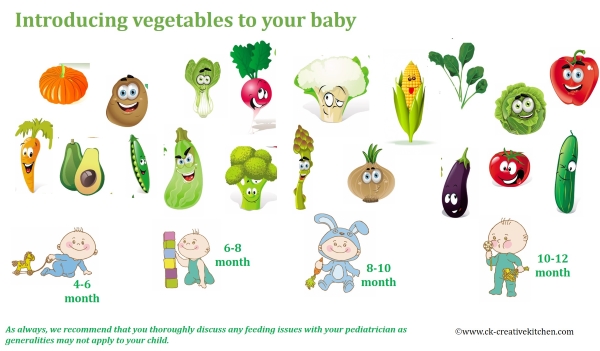
It is important to keep in your mind that your baby has so many years of food experiences ahead that there is no need to rush feeding solods! We offer you pages of useful information and solid food charts for you to review and get a sense of what your baby may be eating at a certain age or stage. This information will help ease your mind as you are introducing solid foods and will also ease the transition to solid foods for your baby.
Current recommendations indicate that breast milk or formula should be baby’s main source of nutrition until at least 6 months of age. While many pediatricians recommend starting solid foods sometime between 4 and six months of age, the earlier introduction of solid foods may have certain risk factors; consult your pediatrician. For example, the “Introduction of complementary feedings [solid foods] before 6 months of age generally does not increase total caloric intake or rate of growth and only substitutes foods that lack needed nutrients and the protective components of human milk (and formula).
You can read more about Breastfeedingand the Use of Human Milkand APP Policyhere.
How do you know if your baby is ready for solid foods? There are many signs to look for that will indicate that your little one may be ready to begin the journey into solid foods. Your baby may be 3 months old or 4 months old when you start to feel she may need “something more” than formula or breast milk.
Lets see the date of introduction of certain foods (you may download in pdf here):



Your baby will give you clear signs, look some of them:
When you find that your baby is ready for solid foods, consider skipping the boxed cereal and starting out with avocado, sweet potato,applesauce, banana or pear!
You should give your baby one new food at a time, and wait a a minimal of 2 to 3 days before starting another. Many parents follow the “4 day wait rule” and choose to wait 4 days between introducing new foods. After each new food, watch for any allergic reactions such as diarrhea, rash, or vomiting. If any of these occur, stop using the new food and consult with your child’s doctor.
Each baby will have unique food preferences, but the transition should go something like this over time:
“Complementary feeding should be timely, meaning that all infants should start receiving foods in addition to breast milk from 6 months onwards. It should be adequate, meaning that the nutritional value of complementary foods should parallel at least that of breast milk. Foods should be prepared and given in a safe manner, meaning that measures are taken to minimize the risk of contamination with pathogens. And they should be given in a way that is appropriate, meaning that foods are of appropriate texture and given in sufficient quantity.” WHO Complementary Feeding
Further, the “WHO recommends that infants start receiving complementary foods at 6 months of age in addition to breast milk, initially 2-3 times a day between 6-8 months, increasing to 3-4 times daily between 9-11 months and 12-24 months with additional nutritious snacks offered 1-2 times per day, as desired.”
Remember, always consult with your pediatrician regarding introducing solid foods to your baby and specifically discuss any foods that may pose allergy risks for your baby.
Become part of the CK community by uploading and sharing traditional or personal recipes. Once you've logged in you can upload, save and print your dishes online.